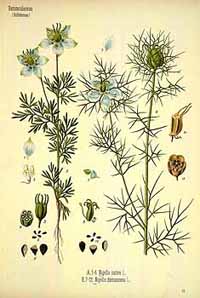Alluring Love-in-a-Mist
By Audrey Stallsmith

Doth the plowman plow all day to sow? Doth he open and break the clods of his ground? When he hath made plain the face thereof, doth he not cast abroad the fitches. . ?
Isaiah 28:24-25a
Legend holds that red-bearded Frederick I was seduced away from the crusades by a green-haired water nymph, who lured him into a foggy Turkish stream and drowned him. The moisture-loving nigella plant supposedly sprang up as that sprite’s reincarnation, with its mist-encased blooms now standing for perplexity in the Language of Flowers.
Frederick, AKA Barbarossa, did perish in what is now the Goksu River in Turkey--possibly in an attempt to swim his horse across because he was too impatient to wait for other soldiers to clear the bridge. However, In that case, masculine bravado would have been to blame rather than the aforesaid nymph.
Besides, nigella already had been around for centuries by that point, its seeds even being found in King Tut’s tomb. Its name means "black," and its family is part of the buttercup clan, with damascena being best known for its flowers and sativa for its spicy seeds. The former plant has been called love-in-a-mist, love-in-a-tangle, devil-in-a-bush, jack-in-prison, ragged lady, nutmeg flower, etc., while the latter often is more prosaically known as black seed.
Its species name translates as “useful.” Although most other of its monikers—such as black cumin, fennel flower, black caraway, black onion, onion seed, and Greek or Roman coriander--compare it to other herbs or spices, black seed is ancient and useful enough to stand on its own merits.
Believed by some scholars to be the fitches mentioned in the scripture at the head of this article, it originated in western Asia and the Middle East and has long been a popular culinary spice and cure-all in that part of the world. It has feathery foliage, green-tinged blue or white flowers, and seeds that reportedly taste like a combination of onion, pepper, and oregano. These days, they often are marketed under the names kalonji or charnushka.
An Arabic proverb described them as “the medicine for every disease except death.” Modern research has discovered that consumption of those seeds or their oil does, indeed, stimulate the immune system, dilate the bronchial tubes, inhibit tumors, and bestow other healthful benefits. However, it’s unlikely that they would increase a woman’s bust size--as they once were believed to do--unless she ate enough of them to gain weight.
The garden flower species of nigella, damascena, means “from Damascus.” That might be misleading since it reportedly originated in southern Europe and northern Africa. The plant makes exquisite annual blooms, to which have been added shades of pink and purple as well as the original blues and whites. Its seeds reportedly smell like strawberries and taste more of nutmeg than onion.
Keep in mind that nigella seeds do contain some alkaloids, apparently in low enough doses that they aren't toxic when used in reasonable amounts. Still, I would refrain from consuming large quantities of the spice at once.
Speaking of which, like a little spice, a little confidence can be a good thing. But don't let it seduce you into dangerous hubris. Just remember that the man who conquered armies was, in the end, conquered by a current.
The Nigella sativa and damascena image is from Kohler's Medizinal Pflanzen, courtesy of plantillustrations.org.








